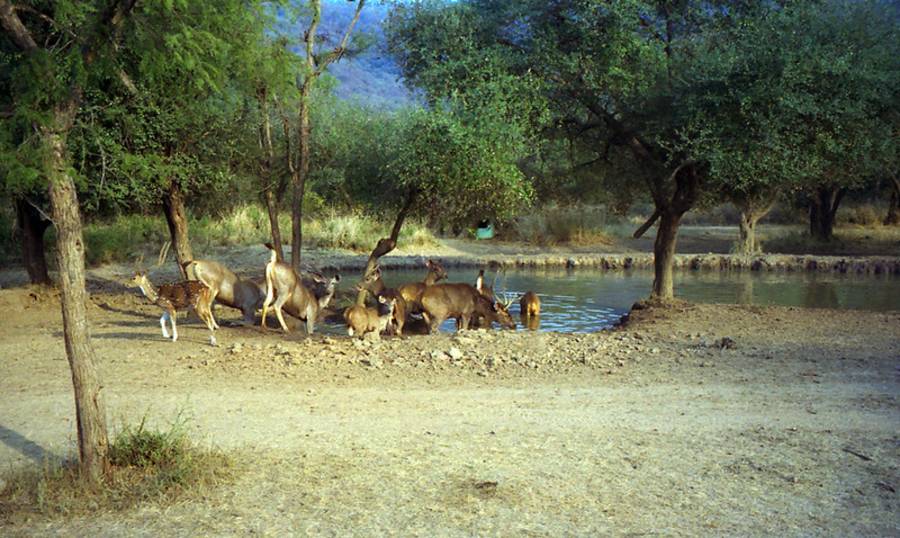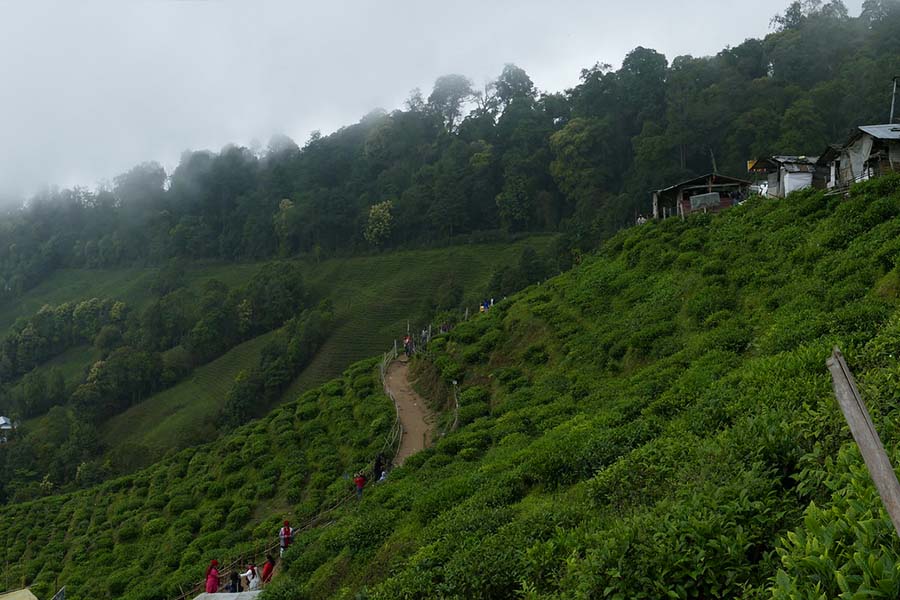Sariska Tiger Reserve
Located in the state of Rajasthan, India, Sariska Tiger Reserve is a sprawling wildlife sanctuary that spans over 1,200 square kilometers. It was established in 1955 as a wildlife reserve and later declared a national park in 1979. Nestled amidst the Aravalli Range, this reserve is home to diverse flora and fauna, most notably the majestic tigers that roam its forests.
Preserving tiger reserves in India is of utmost importance due to the critical role that tigers play in the ecosystem. As apex predators, tigers help maintain a balanced ecosystem by regulating prey populations and preventing ecological imbalances.
History of Sariska Tiger Reserve
Sariska Tiger Reserve has a rich history that dates back centuries. It was initially created as a hunting ground for the royalty of Alwar, a princely state in Rajasthan. However, with the decline of the royal family and the mounting concern over the decreasing tiger population, the reserve was established to protect and preserve these magnificent creatures.
Throughout history, the reserve has faced its fair share of challenges. In the early 2000s, Sariska Tiger Reserve made headlines due to the alarming disappearance of all its tigers. Poaching and lack of adequate protection were identified as the main contributing factors to this crisis. However, determined efforts were made to rehabilitate the reserve and reintroduce tigers, leading to a remarkable revival in recent years.
Biodiversity in Sariska Tiger Reserve
Sariska Tiger Reserve boasts an incredible diversity of flora and fauna, making it a haven for wildlife enthusiasts and researchers alike. The forested landscapes are adorned with a myriad of plant species, including dhok, madhuca, and ber trees, which provide crucial habitats for a wide range of animals.
The reserve is not only renowned for its tiger population but also for the presence of other iconic animal species. Leopards, jungle cats, hyenas, and wild dogs can be spotted, along with a variety of deer species such as sambar, chital, and nilgai. Birdwatchers will delight in the diverse avian species that call Sariska home, including peafowls, eagles, owls, and vultures.
Tiger Conservation Efforts
Sariska Tiger Reserve has been at the forefront of various initiatives aimed at conserving and protecting the tiger population. These efforts include anti-poaching patrols, habitat restoration, and scientific monitoring of tiger movements.
One notable success story is the rehabilitation and reintroduction of tigers into the reserve. Through a carefully planned program, tigers from other reserves were translocated to Sariska, resulting in the establishment of a stable and thriving population. This accomplishment serves as a testament to the dedication and perseverance of conservationists and authorities involved in safeguarding these majestic predators.
Conservation Challenges and Solutions
Preserving Sariska Tiger Reserve comes with its fair share of challenges. One of the major hurdles is human-wildlife conflict, as the reserve is surrounded by human settlements. Encroachment on the reserve’s boundaries poses a threat to both the habitat and the tiger population. Additionally, poaching remains a persistent threat due to the illegal wildlife trade.
To address these challenges, a multi-faceted approach is crucial. Advanced technology, such as the use of drones and camera traps, aids in monitoring and protecting the tigers and their habitat. Moreover, community involvement plays a pivotal role in fostering a sense of ownership and responsibility towards conservation efforts. Engaging local communities in participatory decision-making processes ensures the long-term sustainability of the reserve.
Tourism in Sariska Tiger Reserve
Sariska Tiger Reserve welcomes responsible tourism practices that strike a harmonious balance between experiencing nature’s wonders and minimizing ecological impact. Visitors have the opportunity to embark on thrilling safari tours, guided by experienced naturalists who provide insights into the reserve’s unique ecosystem.
Popular attractions within the reserve include the ruins of medieval temples, such as the Neelkanth and Garh Rajor temples, which offer visitors a glimpse into the region’s rich cultural heritage. Nature enthusiasts can also explore the Kankwari Fort, an ancient structure nestled within the reserve, showcasing the historical legacy of the area.
Research and Scientific Studies
Ongoing scientific research in Sariska Tiger Reserve is crucial for better understanding and conserving its unique ecosystem. Researchers focus on topics such as tiger behavior, habitat restoration, and the impact of climate change on wildlife populations.
These studies contribute invaluable knowledge to the field of tiger conservation, aiding in the formulation of evidence-based strategies necessary for the long-term survival of these magnificent creatures. By conducting comprehensive research, scientists and conservationists can develop targeted approaches to protect and restore the biodiversity of the reserve.
Local Communities and Sariska Tiger Reserve
The establishment of Sariska Tiger Reserve has had profound impacts on the local communities residing in the vicinity. While some livelihoods have been adversely affected due to restrictions on land use, others have found opportunities for sustainable development through eco-tourism and employment in various conservation projects.
Local communities play an essential role in the conservation of the reserve. Engaging them in conservation programs through capacity building, employment, and educational initiatives fosters a sense of ownership and responsibility towards preserving the rich natural heritage of Sariska.
Relationship between Sariska and Other Tiger Reserves
Collaboration among different tiger reserves in India is crucial for the effective conservation of these endangered species. Sariska Tiger Reserve actively participates in knowledge-sharing initiatives and best practices forums with other reserves. This exchange of experiences and lessons learned enables conservationists to develop effective strategies for tiger conservation across the country.
Sharing resources, expertise, and success stories strengthens the collective efforts aimed at protecting these magnificent predators and their habitats. Collaborative initiatives contribute to the conservation of tigers beyond the boundaries of a single reserve, ensuring the long-term survival of the species.
Government Policies and Legal Framework
Sariska Tiger Reserve operates under the framework of various laws and regulations designed to protect its unique biodiversity. The Wildlife Protection Act, 1972, serves as the cornerstone of tiger conservation efforts in India. It provides legal protections against poaching, trade, and habitat destruction.
The effectiveness of these policies relies on their enforcement and the commitment of government agencies. Regular monitoring, punitive measures against violators, and continuous evaluation of policies are essential to ensure the effective preservation of Sariska Tiger Reserve.
Sustainable Development and Sariska Tiger Reserve
Balancing conservation efforts with sustainable development is a key focus for Sariska Tiger Reserve. To minimize the ecological footprint of tourism, innovative and eco-friendly practices are being adopted. These include promoting responsible waste management, encouraging the use of renewable energy sources, and implementing sustainable agricultural practices.
The adoption of sustainable development strategies not only safeguards the reserve’s natural heritage but also creates socio-economic opportunities for local communities. By combining conservation with sustainable development, Sariska strives to be a model for environmentally conscious growth.
Role of Non-Governmental Organizations (NGOs)
Non-Governmental Organizations (NGOs) play a crucial role in conserving Sariska Tiger Reserve. These organizations contribute to conservation efforts through funding, community engagement, and scientific research. By collaborating with government agencies and local communities, NGOs enhance the effectiveness of tiger conservation initiatives.
The partnership between NGOs and government agencies creates a synergy that leverages resources and expertise from both sectors. Through joint efforts, stakeholders can effectively address the complex challenges and opportunities presented by Sariska Tiger Reserve.
Education and Awareness Initiatives
Environmental education programs are instrumental in raising awareness about tiger conservation among local communities and tourists. These programs enhance understanding of the importance of conserving Sariska Tiger Reserve and the role each individual can play in its preservation.
Educational initiatives include workshops, awareness campaigns, and outreach programs targeting schools, colleges, and local communities. By fostering a sense of responsibility and appreciation for the natural wonders of Sariska, these programs pave the way for long-term sustainable conservation practices.
Community-based Ecotourism
Community-based ecotourism initiatives have emerged as an effective approach to preserving Sariska Tiger Reserve while promoting socio-economic growth. By involving local communities in tourism activities, residents become stakeholders in conservation efforts while reaping the benefits of responsible tourism.
Community-based ecotourism projects empower local communities through skill development, job creation, and revenue generation. The active involvement of local communities in decision-making processes ensures that the benefits of tourism are equitably distributed, leading to sustainable socio-economic growth.
Future Challenges and Opportunities
As Sariska Tiger Reserve progresses in its conservation journey, it faces a myriad of potential challenges. Climate change, habitat degradation, and human-wildlife conflict remain pressing threats that need to be addressed effectively to safeguard the reserve’s biodiversity.
However, these challenges also present opportunities for further growth and success. By implementing adaptive strategies, embracing technology, and fostering collaborative partnerships, Sariska Tiger Reserve can overcome challenges and continue its mission of preserving and protecting India’s majestic tigers for generations to come.
Hotel near Sariska Tiger Reserve
There are several hotels and resorts near the Sariska Tiger Reserve in Rajasthan, India, that cater to different budgets and preferences. Keep in mind that the availability and quality of accommodations can change, so it’s a good idea to check the latest reviews and availability before making a reservation. Here are a few options to consider:
- Sariska Palace: This is a heritage hotel located near the Sariska Tiger Reserve. It offers a blend of modern amenities and a royal experience in a historic setting.
- Sterling Sariska: Sterling Sariska is a popular resort located close to the reserve. It offers comfortable rooms and a range of amenities.
- Alwar Bagh by Aamod: This resort is situated a bit further from the Sariska Tiger Reserve but still offers a convenient location. It has spacious rooms and beautiful gardens.
- V Resorts Sariska: This is a mid-range resort with a rustic charm and comfortable accommodations. It’s not too far from the reserve and provides a peaceful atmosphere.
- Sariska Tiger Camp Resort: This budget-friendly option offers cottages and tents for a unique jungle experience. It’s relatively close to the Sariska Tiger Reserve entrance.
- Sariska Inn: Another budget-friendly option, Sariska Inn provides basic accommodations near the reserve. It’s suitable for travelers looking for an affordable stay.
- Treehouse Dwarka Sariska: If you’re looking for something unique, consider staying in a treehouse at this resort. It’s a bit farther from the reserve but offers a distinctive experience.
Remember to check the current availability, prices, and reviews for these hotels and resorts before making a reservation, as conditions can change over time. Additionally, it’s a good idea to book your accommodation in advance, especially during the peak tourist season when Sariska Tiger Reserve is most visited.
Safari Details
Sariska Tiger Reserve, located in the Alwar district of Rajasthan, India, offers safari experiences for visitors who want to explore the wildlife and natural beauty of the reserve. Here are some details about the safari options at Sariska Tiger Reserve:
- Jeep Safari: Jeep safaris are one of the most popular ways to explore the reserve. Visitors can hire a jeep and an experienced guide to take them on a tour of the park. Jeep safaris are available for both the core and buffer zones of the reserve. The core zone is where you have the chance to spot the elusive Bengal tiger, while the buffer zone offers opportunities to see other wildlife like leopards, sambar deer, and various bird species.
- Canter Safari: Canter safaris are larger open vehicles that can accommodate more passengers than jeeps. They are a cost-effective way to explore the reserve and are especially suitable for larger groups. Canter safaris are available for the buffer zone.
- Timings: The safari timings may vary depending on the season, but generally, safaris are conducted in the morning and afternoon. Morning safaris are usually scheduled around sunrise, while afternoon safaris are conducted in the late afternoon, allowing visitors to witness the changing behaviors of wildlife during different times of the day.
- Duration: A typical safari in Sariska Tiger Reserve lasts for about 3 to 4 hours, allowing visitors ample time to explore and observe wildlife.
- Entry Permits: To go on a safari in Sariska, you’ll need to obtain the necessary entry permits and pay the required fees. These permits can usually be obtained at the park’s entry gate or through online booking platforms.
- Best Time to Visit: The best time to visit Sariska Tiger Reserve for wildlife sightings is during the winter months, from October to March, when the weather is cooler and animals are more active. However, the reserve is open year-round.
- Rules and Regulations: Visitors are expected to follow strict rules and regulations during safaris to ensure the safety of both wildlife and humans. These rules include maintaining a safe distance from animals, not making loud noises, and not feeding or disturbing the wildlife.
- Guide: It’s mandatory to have a trained and certified guide accompany you on the safari. These guides are knowledgeable about the park’s flora and fauna and can enhance your safari experience by helping you spot and understand the wildlife.
- Camera Fees: If you plan to bring a camera or video equipment into the reserve, you may need to pay additional camera fees.
Summary: Preserving Sariska’s Tigers for Generations to Come
Sariska Tiger Reserve stands as an emblem of conservation and serves as a sanctuary for India’s majestic predators. Through its history, challenges, and accomplishments, Sariska has demonstrated the importance of tiger conservation and the tireless efforts required to protect these magnificent creatures.
The exceptional biodiversity, coupled with successful rehabilitation programs and innovative conservation techniques, make Sariska Tiger Reserve a beacon of hope for ensuring a sustainable future for tigers. It is imperative that we recognize Sariska’s significance in the context of larger conservation efforts and continue to support its preservation for the benefit of future generations.
FAQs about Sariska Tiger Reserve
A. What is the best time to visit Sariska Tiger Reserve?
Visiting Sariska Tiger Reserve during the winter months, from October to March, is ideal as the weather is pleasant, and wildlife sightings are more frequent during this period.
B. Are there accommodations available within the reserve?
Yes, there are several accommodations available near Sariska Tiger Reserve, ranging from luxury resorts to budget-friendly guesthouses, ensuring a comfortable stay for visitors.
C. How can I contribute to tiger conservation in Sariska?
You can contribute to the conservation efforts at Sariska Tiger Reserve by supporting local community initiatives, participating in responsible tourism practices, and spreading awareness about the importance of tiger conservation.
D. Are there any specific rules or regulations for visitors?
Yes, visitors are required to adhere to certain rules and regulations to ensure the safety of both wildlife and visitors. These include maintaining a safe distance from animals, refraining from littering, and following guidelines provided by park authorities.
E. What are the chances of spotting a tiger in the reserve?
Although tigers are elusive creatures, the population at The Tiger Reserve has been steadily increasing. While sightings cannot be guaranteed, the reserve provides a habitat conducive to a healthy tiger population, offering visitors a chance to spot these majestic predators.
Conclusion: A Beacon of Hope for Tiger Conservation
The Tiger Reserve stands as a testament to the power of conservation and the relentless efforts made to protect India’s natural heritage. With its remarkable biodiversity, successful rehabilitation programs, and innovative conservation strategies, Sariska offers hope for the long-term survival of tigers.



